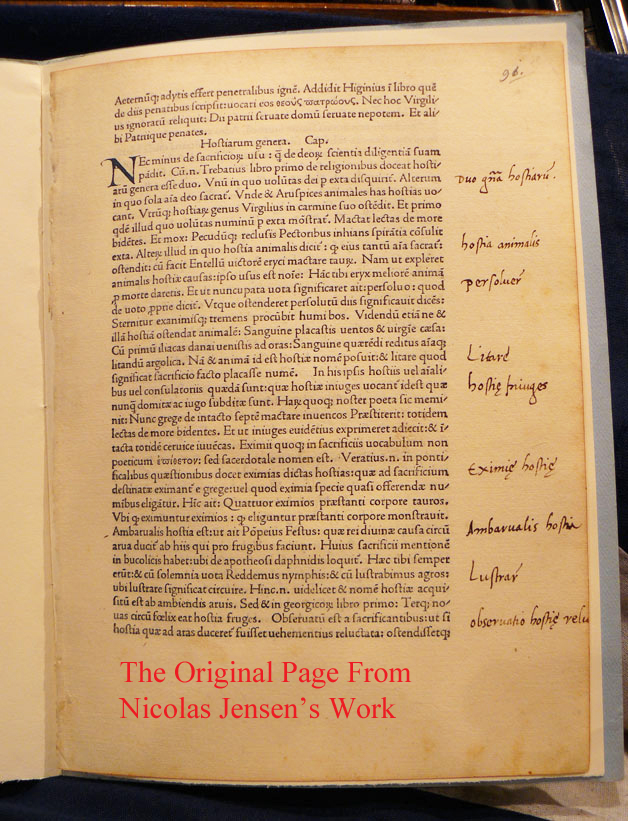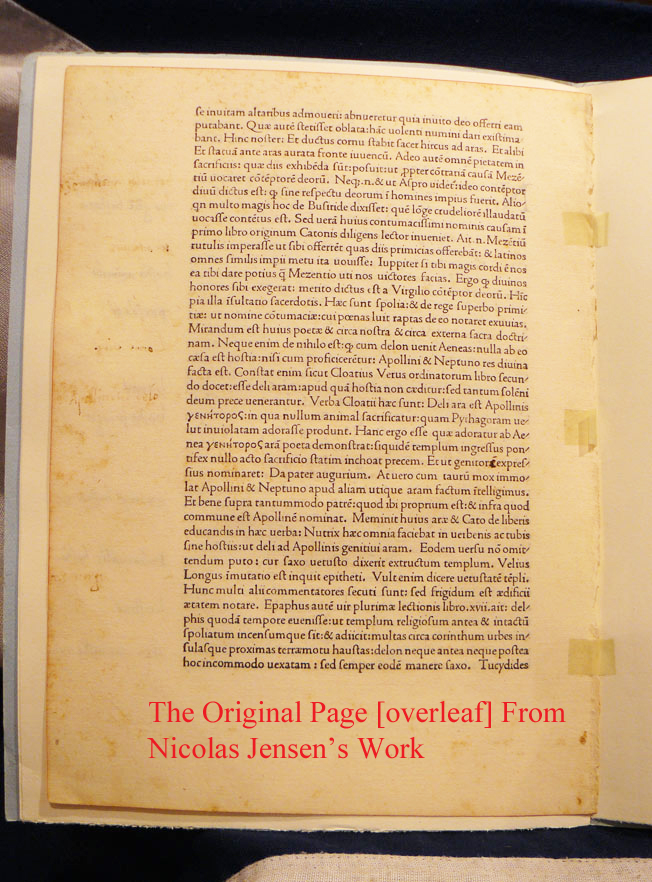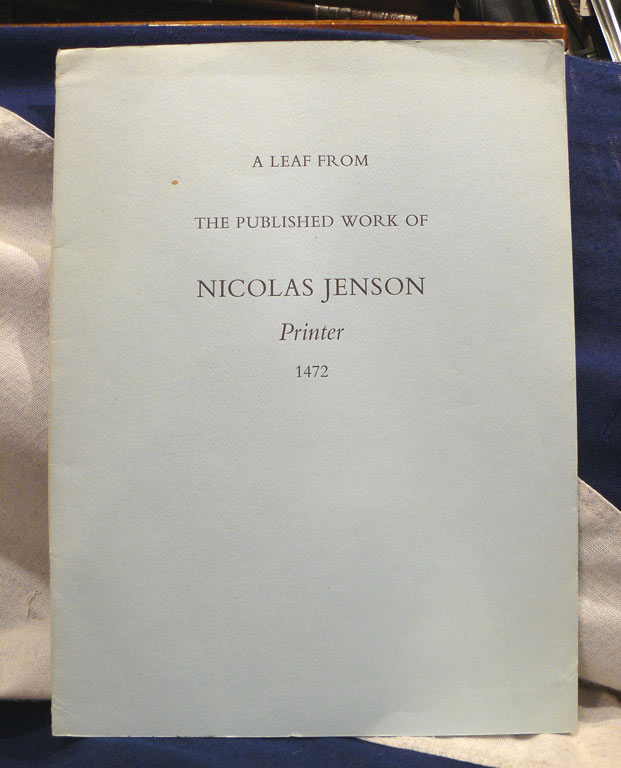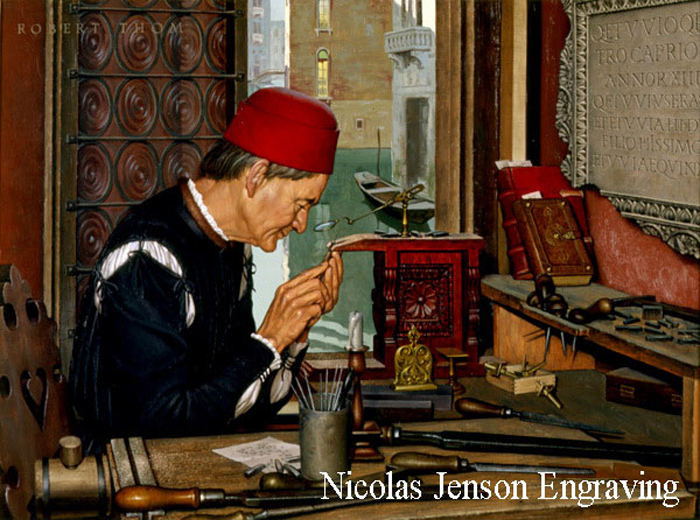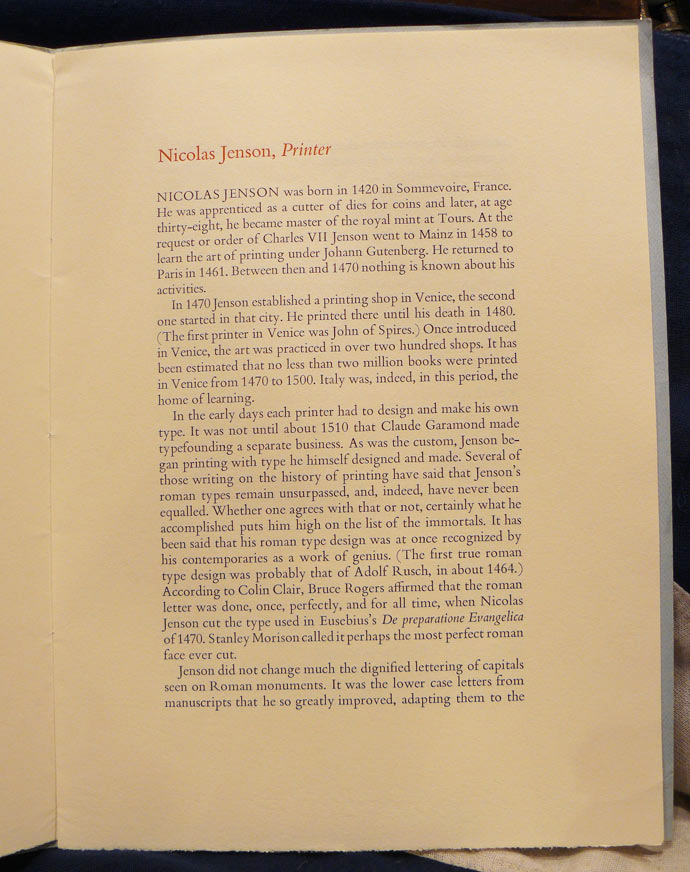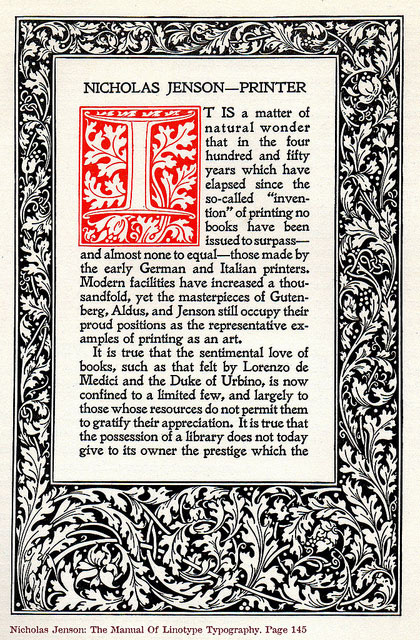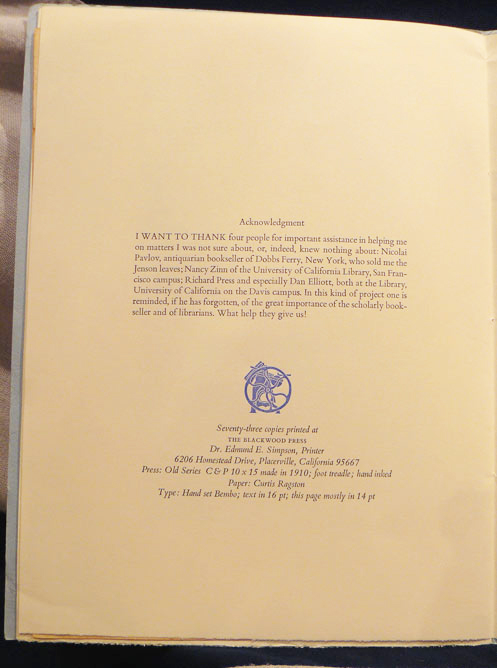A Unique Leaf From The Published Work of Nicolas Jenson Printed in 1472
A single original surviving leaf from one of the earliest and rarest books ever printed. A complete volume of this work, if were ever to be on the open market could be worth well over a million pounds. Nicolas Jensen, who is roundly considered one of history?s greatest printers and typographers, turned out beautiful volumes from his Venetian workshop in the 15th century. There is a similar leaf from Diogenes Laertius, Lives of the Philosophers by the Jensen Press, 1475. In resides in the Salisbury House Permanent Collection. A great and incredibly rare treasure from the very earliest days of printed text, with original handwritten annotations. This is a Folio. 6pp plus and original unique leaf from Ambrosius Aurelius Theodosius Macrobius's "In Somnium Scipionis Exposito". In Publisher's wrappers. 1 of only 73 ever published folio's that contained an original unique leaf from the master's great work of 1472. In very good condition. In The Manual Of Linotype Typography, the folio containing the rare single leaf was published in 1923, he clearly regarded him as one of the three greatest master printers of all time, alongside Gutenberg and Aldus. To own an original unique piece of Jenson's work, with annotations may be considered by some as one of the greatest privileges afforded to admirers of the printed word. An entire volume would be priceless, or at the least exceeding a million pounds or considerably more. Some hypothesize that Jenson studied under the tutelage of Gutenberg, the man who printed the rarest and most valuable book of all time, the Gutenberg or Mazarin Bible [one was apparently lost on the Titanic]. Jenson worked before the greatest English printer, the legendary William Caxton, and the very first book ever to be printed in English by Caxton was in 1473, "Recuyell of the Historyes of Troye" Jenson's story; In October 1458, while acting as Master of the French Royal Mint, Jenson was sent to Mainz, by King Charles VII, to study the art of metal movable type. Jenson then went to Mainz to study printing under Johannes Gutenberg. In 1470 he opened a printing shop in Venice, and, in the first work he produced, the printed roman lowercase letter took on the proportions, shapes, and arrangements that marked its transition from an imitation of handwriting to the style that has remained in use throughout subsequent centuries of printing. Jenson also designed Greek-style type and black-letter type. By 1472, Jenson had only been printing for two years. Even so, his roman type quickly became the model for what later came to be called Venetian oldstyle and was widely imitated. Though Jenson's type was soon superceded in popularity by those of Aldus and Garamond, it was revived again by William Morris in the late 19th century and became the model of choice for a number of private press printers.
Twentieth century commercial interpretations include Centaur and Cloister lightface, and most recently, ITC Legacy and Adobe Jenson. The books of Johann and Wendelin de Spira were printed with a new fount, a roman
type; this was a style of type that is familiar to the present day, but was at the time a radical innovation. A year later, in 1470, a new, slightly lighter and more elegant version appeared in books with a new imprint, that of Nicolas Jenson. In the colophons of books
printed from 1470 his name appears along with praise for his typographical skills. It is here that we see for the first time statements that leave no room for doubt. Jenson hasrightly become famous as the designer and cutter of the punches for the new roman typefaces as well as other founts that for a long time were the standard for legal and
theological works. Confirmation of his status as typographer is found in his last will and testament, written in 1480, where he made careful dispositions for what should be done
with his punches, the tangible results of a life?s experience and work that he wished to be protected. All these circumstances together lead to the notion that it was Jenson who improved the production of movable type by cutting excellent punches, a skill that he
had brought from the traditions of the Mint in Paris, and that he may first have applied inMainz to the long-lasting types used by Fust and Schoeffer.It is only in the last ten years of his life that Nicolas Jenson abandoned his anonymity,
and became prominent as a printer of magnificent books. Executed in sober, almost sculptural layouts they became models for centuries of printing. A famous example is the monumental edition of Pliny?s classical encyclopaedic work, his Historia naturalis, published by Jenson in 1472. An Italian translation, also published by Jenson, appeared in 1476 . The translation and printing were commissioned by the Florentine merchant Girolamo Strozzi, who also took care of the marketing.
Following in the tradition of Thomas Jefferson, whose library contained numerous works on European history, politics, and culture, the Library of Congress has many comprehensive European collections. The rarest of these works come to the Rare Book and Special Collections Division.
A special category of the division's European holdings is its collection of incunabula--books printed before 1501. Printed during the first decades of printing with movable type, these very rare and valuable books cover the whole spectrum of classical, medieval, and Renaissance knowledge and represent many of the highlights of the division's European materials. Over its nearly two-hundred-year history the Library of Congress has collected nearly 5,700 fifteenth-century books, the largest collection of incunabula in the western hemisphere. When Congress originally established its Library in 1800 and saw its collections destroyed by fire in 1814, it had no fifteenth-century books. Neither did the collection that Thomas Jefferson sold to Congress in 1815. This is not surprising because the books in the first Library served the need for general literature, and Jefferson primarily collected modern, scholarly editions in handy formats.
For the first fifty years or so after the acquisition of Jefferson's collection, the Library acquired incunabula very sparingly. The 1839 Catalogue of the Library of Congress lists only 2 incunabula: the Chronecken der Sassen (Mainz: Peter Schoeffer, 6 March 1492) and Ranulphus Hidgen's Polychronicon (Westminster: Wynkyn de Worde, 13 April 1495). The earliest incunabulum with a recorded date of acquisition is a 1478 edition of Astesanus de Ast's Summa de casibus conscientiae (Venice: Johannes de Colonia and Johannes Manthen, 18 March 1478).
The date that marks the real beginning of the incunabula collection at the Library of Congress is April 6, 1867, when the last shipment of Peter Force's library was received at the Capitol. His personal library held approximately 22,500 volumes, including 161 incunabula. The collection had some important books. The earliest imprint was Clement V's Constitutiones (Mainz: Peter Schoeffer, 8 October 1467); also included were a copy of Hartmann Schedel's Liber chronicarum (Nuremberg: Anton Koberger, 12 July 1493) and Jenson's printing of Pliny's Historia naturalis (Venice: Nicolaus Jenson, 1472).
Gutenberg, Aldus and Jenson
Code: 22403
2250.00 GBP

